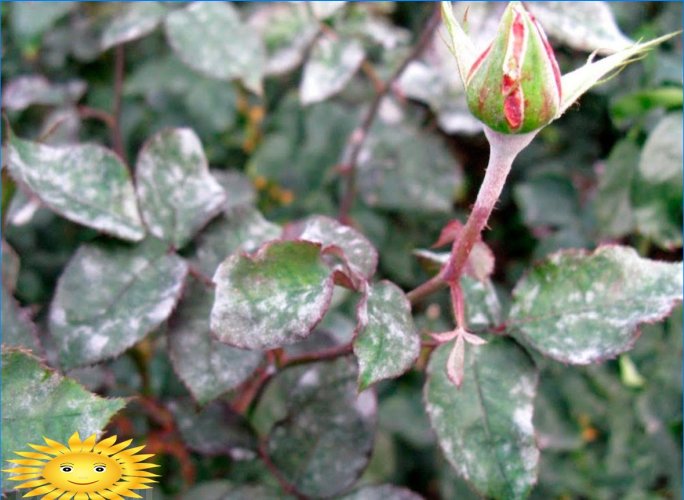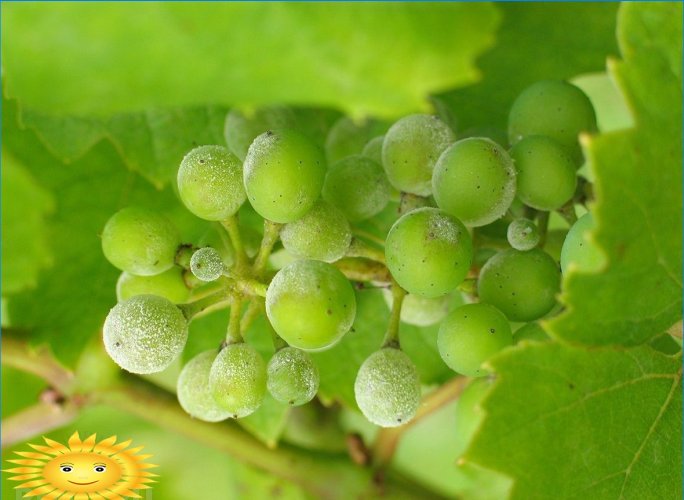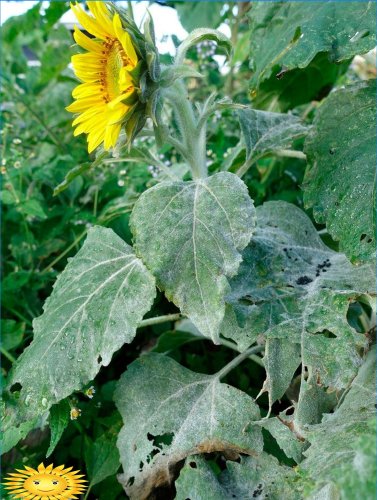Many gardeners and gardeners are faced with such an unpleasant problem as the appearance of powdery mildew. She can literally ruin the crop in the bud. Our site of tips decided to find out what powdery mildew is, why and when it appears, what measures can be taken to combat it.
Other names for powdery mildew are linen and ash, which is associated with the first, most noticeable sign of this disease. Powdery mildew is caused by microscopic fungi from the order of powdery mildew and erisyphus. Such imperfect mushrooms cause the appearance of a powdery white mycelium on plants. When it ripens, drops of moisture appear, which is the reason for the main name of this plant disease..
Powdery mildew can affect almost any plant: roses, currants, gooseberries, garden strawberries, tomatoes, cucumbers, melons, grapes … The list can be long. According to experts, there are many types of imperfect mushrooms, each of which affects its “favorite” type of cultivated plants. But the signs of the disease and the consequences of powdery mildew are the same for all crops..
First, a whitish coating of mycelium appears on the stems and leaves that are closest to the ground. Then it covers the whole plant – all leaf plates, petioles, stalks and the fruits themselves. The leaves begin to wither, wither, the plant gradually dies, because the fungus takes nutrients from it, and the process of photosynthesis in the foliage stops. The fruits rot and gardeners cannot harvest.
It is almost impossible to predict where exactly the pest fungi that cause the appearance of powdery mildew will appear. In one year, gardeners successfully grow vegetables, flowers, and berries, and the next year they face this problem, as they say, “to their full height.”.
Experts emphasize that powdery mildew most often appears under the following conditions:
- Prolonged rains when the humidity rises to 60%, or even 80%;
- Summer temperature is low, does not exceed + 27 ° C and often drops below + 20 ° C;
- The temperature change is abrupt – it is cool at night, during the day it can be very hot;
- The soil contains too much nitrogen;
- The plants are too densely planted;
- The owners do not observe the watering regime – they either allow the beds to dry out, or they overfill the plants;
- A radical pruning of shrubs and grapes was carried out, the owners tried to rejuvenate the plants.
Summer residents cannot influence many of the reasons for the appearance of powdery mildew – what to do if the summer is rainy and cold! Just humble yourself and try to help the plants. But there are still measures to prevent this fungal disease.
To prevent powdery mildew, we advise you to adhere to the following rules:
- Observe the watering regime, carry it out only when the topsoil has noticeably dried out. And do not over-flood the plants;
- Plant the plants, observing the optimal spacing between them, not too densely;
- In the spring, carry out sanitary pruning of shrubs;
- Correctly plan a vegetable garden, the arrangement of beds and plants, taking into account the principles of crop rotation;
- In the fall, remove the remnants of tops and leaves from the beds so that pests do not remain in the soil;
- Carry out preventive spraying of trees and shrubs with special protective preparations, including copper chloride, copper sulfate, colloidal sulfur, as well as other compounds of zinc, copper and iron;
- Do not get carried away with nitrogen fertilizers, especially at the stage of bud formation;
- Timely apply phosphorus and potash fertilizers, add humus, compost, peat to the soil, work to improve the condition of the soil annually.
If powdery mildew has already appeared on the plants, you need to urgently take action! First, tear off the affected lower leaves that are affected first. And spray all the plants in the garden with fungicides. Popular drugs today: “Topaz”, “Fundazol”, “Baylon”, “Skor”, “Topsin”, “Quadris”. Biofungicides are also used: “Pseudobacterin-2”, “Fitosporin-M”, “Gamair”, “Alirin-B”.
Important! Although the portal did not advise you to burn fallen leaves, telling you how you can use them, in the case of powdery mildew, drastic measures are needed! The affected foliage will have to be burned to avoid spreading the disease. Or take it to a landfill, away from home.
If you prefer to fight powdery mildew using traditional methods, you can use one of the following recipes:
- A liter of water plus 4 grams of soap and the same amount of soda ash or regular baking soda. Spray the plants with this solution once a week;
- Ash tincture with soap. You need half a glass of ash per 1 liter of boiling water, soap, as in the previous recipe, about 4 grams;
- Fermented water. Just weeds that are finely cut and filled with hot water. The infusion is kept for a couple of days, filtered and used for spraying plants;
- Fresh mullein. Manure is poured with water and kept for three days, then filtered and diluted with water 1:10;
- Sour milk, kefir, sour milk. These products are diluted 1:10 with cold water and are also used for plant spraying..
It is not easy to finally defeat powdery mildew on your site, there is no guarantee that the disease will not return next year if conditions are suitable for the fungus. However, the methods of prevention and control described by us will help you avoid serious crop losses and cope with the problem..
Powdery mildew: causes and methods of struggle
Powdery Mildew is a common fungal disease that can cause damage to plants, flowers, trees, and vegetables. This article outlines the causes of Powdery Mildew as well as ways to counter its effects. First, Powdery Mildew can be caused by excessive humidity, or long periods of leaf wetness. Additionally, it is spread through the wind, and spores can be harbored on both leaves and other surfaces. Its effects can be distinguished by white, gray, or orange splotches on leaves, stems, and fruits. To combat this airborne fungal disease, gardeners should take preventative action by allowing plants to grow with enough room for air circulation, keeping foliage dry, and removing diseased plants immediately. Additionally, fungicide can be used to treat the infected areas, and organic alternatives exist as well. By following these steps, gardeners can protect their plants from the dangers of Powdery Mildew.
Improvement of the territory







What are the most effective methods to combat powdery mildew and what are the potential causes of this issue in plants?
The most effective methods to combat powdery mildew in plants include improving air circulation, reducing humidity, applying fungicides, pruning infected areas, and implementing proper plant care practices. Powdery mildew is caused by various fungi and can be triggered by factors like high humidity, poor air circulation, overcrowding of plants, lack of sunlight, and improper watering. By addressing these potential causes and implementing appropriate control measures, such as maintaining proper plant spacing and monitoring moisture levels, the spread and severity of powdery mildew can be significantly reduced.